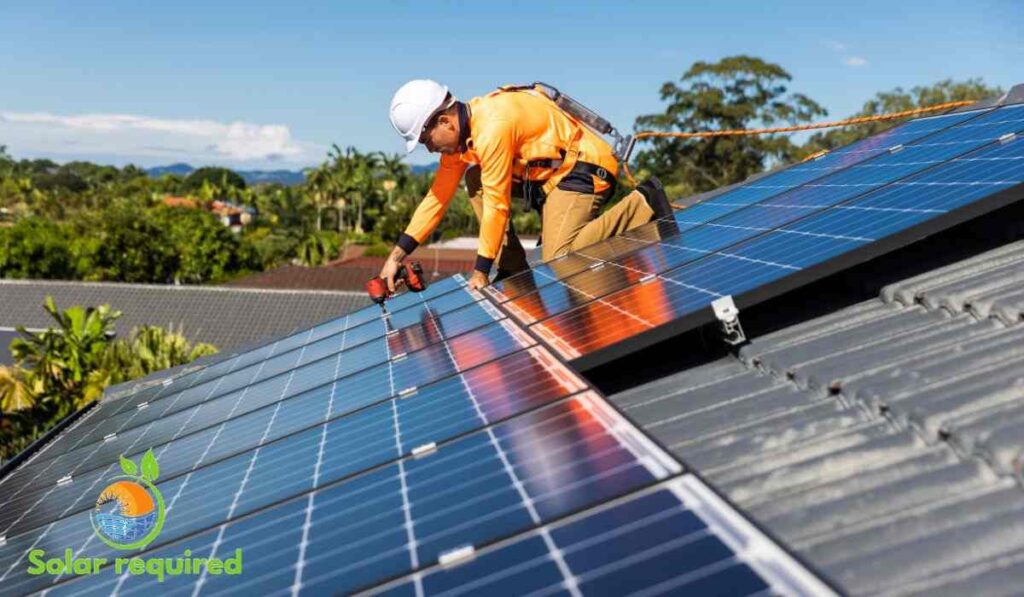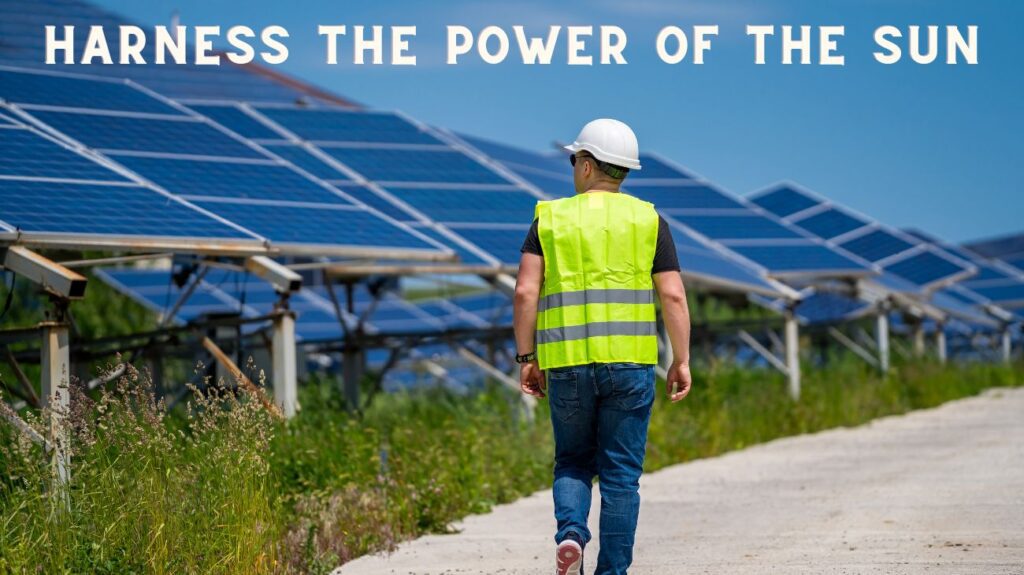Many businesses and homeowners must install solar panels. This is vital for pursuing energy independence and sustainable living. Understanding the best solar panel installation techniques is more crucial than ever.
This is because of the rising need for renewable energy options. A well-installed system produces the most energy, is highly efficient, and greatly increases its lifespan. It’s critical to keep up with the newest concepts for installing solar panels. Solar technology is developing, and as it does, the best approaches for panel placement and connection also change.

This post covers installing solar panels. It explains how to mount the panels, connect the parts, test the system, and comply with safety and legal rules. It also highlights the best solar installation practices. The goal is to give readers the knowledge to ensure their solar projects are perfect, whether they’re DIY projects or work with professionals. Learn more about DIY solar panel kits.
Understanding these points can greatly impact your solar system’s success and efficiency. In addition, the guide will share tips for efficient operation. They will help you get the most from your investment in solar energy. This makes the guide a must-have for anyone interested in the power of the sun.
Step-by-Step Solar Installation
Gather Materials and Tools for solar installation.
They are acquiring the required instruments and supplies before beginning the solar panel installation. This includes mounting kits and solar panels. It also has various tools like tarps for protection, wrenches, and angle rulers. To ensure all the parts are ready, homeowners should speak with their installation team.
Setting Up the Installation Location
The installation location must be free of obstacles to ensure a secure and effective setup. These include trees and stumps. Also, homeowners should consider how much sunlight the solar panels get. They should prune any trees that might shade them. You must assess the site’s topography and weather. This tells you what civil construction measures are needed. They are for erosion control and landscape sculpting.
Mounting the Solar Panels
Mounting solar panels requires precise placement and firm anchoring. Start by setting up the mounting rails and roof attachments. Consider the roof type. Use the right fasteners and flashing to prevent leaks. Solar panels should be tilted at a low angle. This helps avoid dust buildup and maximizes energy absorption. Position the array to allow clear airflow. This will enhance the cooling and efficiency of the panels.
If you ever have to uninstall a solar panel after installation, you can read this information to learn how to safely uninstall solar panels.
Connecting electrical components
Wiring the Panels
Understand the right connection types to wire solar panels correctly in systems. For example, series connections raise the voltage. They keep the current constant by connecting the positive terminal of one solar panel to the negative terminal of the next. As an alternative, parallel connections raise the current. They do this by keeping a constant voltage. Connecting all positive and negative terminals accomplishes this. These techniques guarantee the solar panel system’s maximum effectiveness and functionality.
Setting Up Inverters
It’s important to connect the solar panels to a charge controller. 5 problems can be encountered when setting up an inverter. Do this before installing the inverter. This is important when working with high-voltage PV modules. This configuration guards against inverter damage and helps control voltage. The connection should use stranded copper core wires. They can handle the current well, ensuring a secure and efficient setup.
Connecting to the electrical system
The final step involves connecting the inverter to the home’s electrical system. This includes wiring from the inverter to the AC power box, and if applicable, to the electrical grid. It’s also important to install AC and DC disconnects to enable quick power cutoff for safety or maintenance. Proper grounding and bonding are crucial. They prevent electrical hazards.

Testing and Inspecting the System
Running Initial Tests
To keep all modules the same, technicians measure and log each string’s open-circuit voltage (Voc) and polarity. They do this during the initial testing phase. We also record each string’s short-circuit current (Isc). This ensures that under comparable conditions, all the strings are within 0.1A of each other. If you find differences, they may show shading or a ground fault. You will need to investigate them more. We adhere to the manufacturer’s protocol for initiating the inverter’s operation. This ensures that it checks its automatic shutdown and proper performance.
Making Certain Electrical Safety
Electrical safety is key. Inspectors meticulously scrutinize bonding and grounding for secure compliant connections. Check the solar panels, rails, and metal conduits. Ensure they are grounded and wired right. Inspectors also ensure that AC and DC disconnect switches are well placed. They must be easy to get to in an emergency. We review the whole electrical system. This includes the main service panel and individual connections. We check for compliance with approved plans and safety standards.
Read more about how you can add more panels to your existing solar panel system.
Final Inspection Procedures
The final inspection is a thorough review. It checks the solar panel system’s strength and if it follows the approved plans. Inspectors verify the correct installation of panels, rails, and any structural reinforcements. They also check for the presence and accuracy of required safety and specification labels throughout the system. This thorough assessment ensures the system is up to code. It runs well and is safe for the property and its occupants.
Adhering to legal and Safety Standards
Compliance with local codes
Comply with local codes to install solar panels within legal boundaries. We regularly revise these guidelines. We update them for new safety rules and solar tech changes. For example, to limit moisture damage the International Building Code (IBC) has specific standards.
These include the use of sealants and attachment flashing. All components must also match or beat the fire safety standards. These are the standards of the current structures. Installers must guarantee that the structural load does not exceed the building’s capacity for support.
Safety Precautions During Installation
One cannot overstate the importance of safety during the installation process. According to the International Fire Code (IFC), install solar modules to allow safe access for firefighters. It says panels should not go more than 3 feet below the roof ridge. Furthermore, ground all metallic parts of the solar system to prevent electrical hazards. To meet the National Electrical Code (NEC), follow the manufacturer’s torque specs. Use them for all connections. This is crucial for proper grounding and bonding.
Documenting for Future Reference
Maintaining detailed documentation of the solar installation process is crucial. During inspections check that this documentation follows the right codes and standards. Quality documentation prevents risky and unlawful modifications down the line. It also shows the installation followed the approved plans. This is critical for final inspection approvals.
Tips for Efficient Operation
Maximizing Sun Exposure
To make lots of energy, solar panels should face 180 degrees south. Site conditions and preferences create minimal variations in output alignment. It is best to avoid putting panels in shady regions. Also, avoid the 180-degree arc facing north. These orientations greatly reduce efficiency and return on investment. Read these important instructions before installing the solar panel. Installations that face west can maximize energy credits. This happens during peak rate periods for homes on Time-of-Use (TOU) rates. You can maintain solar panels with DIY or professional maintenance.
Making Use of Monitoring Instruments
You must buy a solar monitoring system. It’s essential for keeping the system working well and saving energy. These systems monitor data on energy generation and system performance in real-time. They make it possible to find and fix problems right away. The tools provide detailed reports and analytics. They help optimize performance and extend the solar installation’s lifespan.
Implementing backup solutions
Adding battery storage boosts energy independence. Increasing battery lifespan is essential so read our guide to increase battery life span. It lets homeowners store solar energy for use during peak demand or outages. This cuts energy costs and gives a reliable power supply. Modern inverters and batteries ensure efficient energy management. They integrate seamlessly with solar panels to maximize usage and savings.
Conclusion
This thorough explanation has stressed the need to follow best practices. These are important in solar panel installation. It covers careful site preparation. It also covers the testing and inspection procedures that ensure efficiency and safety. The article gave readers the knowledge. It will help them start their solar projects.
It did this by outlining the exact process for mounting solar panels and connecting electrical parts. It also stressed the importance of following safety and legal rules. Also, the focus is on practical operation advice. This advice includes making the most of sun exposure and using monitoring tools. It supports solar energy as a dependable and sustainable power source.
FAQs
1. What are the recommended practices for installing solar panels?
Solar panels should be positioned toward the sun for maximum efficiency. It’s common practice to tilt solar panels on flat roofs to maximize energy capture. Furthermore, the panels must be installed without jeopardizing the roof’s waterproof integrity.
2. How should solar panels be oriented for maximum efficiency?
South-facing solar panels generally produce the best results because they can increase energy production by as much as 30%. However, roof slope and location can change the best orientation. This leads some homeowners to think about other options.
3. What strategies can maximize the efficiency of my solar PV system?
Combining a home battery system with solar panels boosts output power. By storing excess electricity produced when you are not home, you can use more of your solar energy later rather than drawing from the grid. This setup increases your use of renewable energy. It also cuts your electricity bills.
4. What is the optimal placement for solar panels to achieve maximum output?
For the most energy output, solar panels in the U.S. should face south. The Department of Energy recommends tilting them 15 to 40 degrees. Even if your roof layout is not ideal, installing solar panels can still be beneficial.


